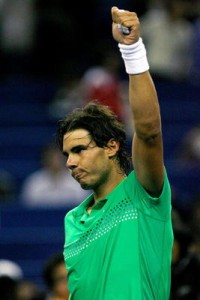Posted on
March 03, 2010 by
Rob York

Roger Federer's records tower over those of his contemporaries.
I remember the GOAT talk starting when Roger Federer crushed Lleyton Hewitt to win the US Open in 2004, his third major of that season. His contemporaries, Hewitt and Andy Roddick, were clearly not equipped with the tools necessary to stop him, or even to slow him down. He struggled more on clay, but it seemed only a matter of time until he figured that out.
Still, I remember thinking that the field would inevitably evolve to catch up with Federer, at least slowing his progress if not stopping it. To an extent that has happened; Rafael Nadal proved a long-term impediment to Federer’s goals of winning in Paris, while Andy Murray and Juan Martin del Potro appear more imposing adversaries than Hewitt and Roddick did.
Yet Federer endures, now with wins at all four majors and 16 total Grand Slam titles, two more than any other player in history. Is there any legitimate metric left to deny him the title of the greatest ever? Read the rest of this entry →
Tags: Men's TennisPancho GonzalezRod LaverRoger FedererTennis
Category
General, Tennis
Posted on
December 05, 2009 by
Rob York

Rafael Nadal's competitive fire has made him a champion
Talent is the beginning, not the end.
There are so many other traits that a tennis player must have to be a champion. Fitness is crucial, as is willingness to prioritize the game above other interests.
But nothing stretches talent and maximizes it quite like mental strength. When most modern tennis fans think of mental toughness and competitive fire, they think of either Jimmy Connors or Rafael Nadal (pictured). It probably comes as no surprise that both of them make my list of the top five.
The only question is where, and whether anyone tops them. Read the rest of this entry →
Tags: Jimmy ConnorsLleyton HewittMen's TennisPancho GonzalezPete SamprasRafael Nadal
Category
Sports History, Tennis
Posted on
December 01, 2009 by
Rojo Grande

Like a hardened tree, Pancho Gonzalez exhibited the posture of resistance.
Not far from my place, there stands an old windswept pine, so hardened by the elements that even on a calm day it exhibits the posture of resistance. It seems unrelenting in its refusal to bow.
More than once, the old tree has symbolized for me the human traits of stubbornness, perseverance, endurance and toughness. Its sinewy skin and tightly-clenched roots tell of a life filled with challenge and pain. Yet it still stands there in defiant victory.
That sun-bleached, aged pine has not merely survived…it has actually thrived. The perplexity of that thought has often brought to mind a particular person. As I set about to research this story, it became clear that my subject was one such person.
Ricardo Alonso Gonzalez, the son of Mexican immigrants, faced the winds of adversity from the onset of his tennis career.
As a young minority teen-ager in 1940s Los Angeles, he was shunned by the upper levels of society. Gonzales often spent time watching tennis enthusiasts unwind at neighborhood parks and public courts.
He was intrigued by the combination of power and finesse that tennis required and would emulate the moves he so diligently observed through the fence. Thus was laid the self-taught foundation of Pancho Gonzales’ fabulous career.
Tennis became his obsession and predictably, his studies and social skills suffered. Truancy and trouble with the law soon followed. Then, a year of juvenile detention.
Though his talent was by now undeniable, his rowdy reputation and cultural roots ensured his exclusion from LA’s upper-crust tennis clubs.
Read the rest of this entry →
Tags: Men's TennisPancho GonzalezWimbledon
Category
Sports History, Tennis






